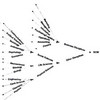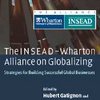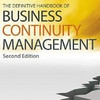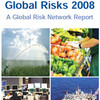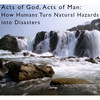 Do we ever learn? How come we humans knowingly and willingly put ourselves and our critical infrastructure in harm’s way time and again? Instead of living with and adjusting to natural hazards, we turn them into natural disasters, by our own doings and short-sighted decisions. That is what Kerry Sieh wrote in 2000 in his article titled Acts of God, Acts of Man: How Humans Turn Natural Hazards into Natural Disasters. In his article, Kerry argues for a different approach to handling the natural hazards that Earth puts beneath our feet, and not just acquiesce to enduring the damage and death brought by natural disasters. Proper engineering is all it takes.
Do we ever learn? How come we humans knowingly and willingly put ourselves and our critical infrastructure in harm’s way time and again? Instead of living with and adjusting to natural hazards, we turn them into natural disasters, by our own doings and short-sighted decisions. That is what Kerry Sieh wrote in 2000 in his article titled Acts of God, Acts of Man: How Humans Turn Natural Hazards into Natural Disasters. In his article, Kerry argues for a different approach to handling the natural hazards that Earth puts beneath our feet, and not just acquiesce to enduring the damage and death brought by natural disasters. Proper engineering is all it takes.
Japan’s misfortune
This article has been in my file cabinet since 2000, and I have often wanted to present it on my blog, but I lacked the right circumstances. I was reminded of it when I was watching a documentary on the recent Japan earthquake and tsunami, where one of of the interviewes, a university professor, said that if you were to locate a major economic powerhouse or manufacturing facilities today, Japan’s northeast coast would probably not be your first choice, perhaps not even among your choices, simply because the earthquake hazard is too great. However, as Sieh points out, it is not a matter of yes or no, but rather a matter of carefully selecting where exactly to locate what.
In living memory
Disasters and earthquakes in particular have happened since the dawn of ages, but very few of them remain in living memory.
Worldwide, about 200 cities with a population of more than 500,000 lie within 100 kilometers of known active faults. But we associate very few of these 200 cities with earthquake hazards, because the Earth’s metabolism is so much slower than ours that most of them have not been devastated by an earthquake in living memory. We think in terms of years or months, not decades or centuries. This low metabolic rate inures us to the fact that the faults are there, that earthquakes happen. Generations come and go, thinking they are perfectly safe, when in fact they are living on a time bomb with a very long fuse.
This is maybe the reason why we build the way we build and forget where we should and where we should not build.
Cleanup or buildup?
Sieh wants us to think before we start building:
In the 20th century, and in fact in the first and second millennia, we just reacted to natural disasters. We basically cleaned up after they happened and continued on as before, leaving our great-grandchildren to suffer the same fate, next time around. Now, at the turn of the century, the turn of the millennium, I suggest we start looking at hazards differently than we have looked at them in the past. Let’s understand them as the geologist or the earth scientist does, so that they don’t destroy our cities, homes, and lives. Let’s actively reduce our exposure to hazards, rather than being just reactive to them.
I think Sieh has a point here, and it is a bit similar to the discussion on preparing or reacting to disasters in the BBC World Debate that I posted on 2 years ago.
How (not) to build
Sieh uses the San Bernardino Valley College as an example of how buildings and facilities could be relocated after taking into account actual fault zones. As seen in the figure below, San Bernardino Valley College sits astride the San Jacinto fault, which runs directly through the campus and some of the college buildings:

Taking the fault line into account, Sieh then proposes a different layout, moving buildings off the fault zone and orienting them parallel to long axis of the fault:
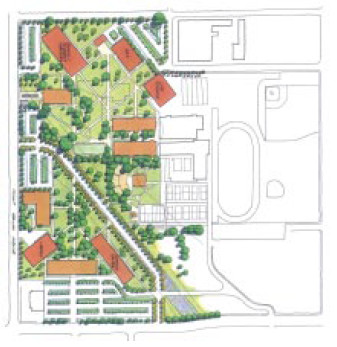
Perhaps something to consider, when locating your next facility, alongside using Snyder’s facility location model? Supply chain risk and supply chain disruption do not just come from within the supply chain, but also from within the supply chain infrastructure, i.e. factories and warehouses.
What we can plan for, we should
Geologists can map volcanic, flood, and tsunami hazards very effectively, Sieh says, but there are some hazards we probably have to ignore, namely immense catastrophes. That said, this should stop us from planning, what we can plan for we should, he contends.
As world population grows from 6 billion to 12 billion or whatever it’s going to be in the next 50 years, we have an opportunity now that will not come around again—an opportunity to choose the places that we’re going to expand into. We have a clear choice: we can live with our beautiful, dangerous Earth as we have in past millennia, or we can learn where to put our bridges, campuses, houses, and factories to minimize the destruction. On my best days, I’m optimistic that we will choose a new vision for the future rather than acquiesce to enduring the damage and death brought by natural disasters as we have in the past.
Let’s hope we do it right, then. Hazards are hazards, there’s no need for making them into disasters if we don’t have to.
Reference
Sieh, Kerry (2000). Acts of God, Acts of Man: How Humans Turn Natural Hazards into Natural Disasters Engineering and Science, 63 (4), 8-17
Author link
- wikipedia.org: Kerry Sieh
Download
- caltech.edu: Acts of God or Acts of Man
Related posts
- husdal.com: A typology of crises
- husdal.com: Reliable facility location

